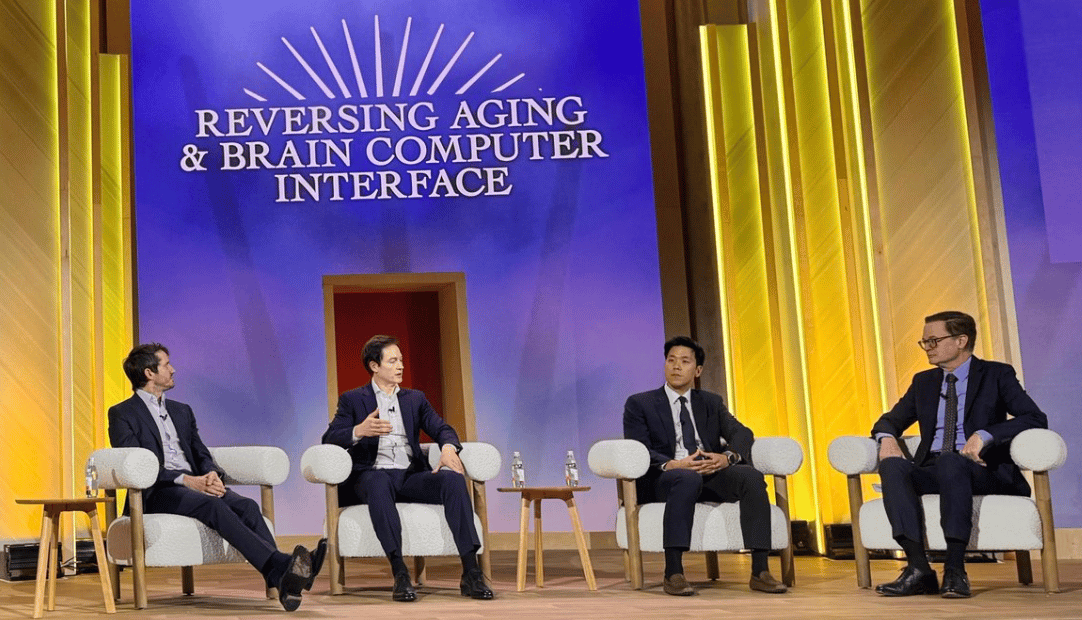
New to LEVITY? Start here! Want to know more about who’s behind LEVITY? Check out this page. 🙏🏼 Not subscribed to the LEVITY podcast on Youtube yet? Do it here. 🎧 More of a listener? The podcast is also available on Spotify, Apple Podcasts and other places.

Reversing aging requires more than a backdrop
A few days ago, social media was full of celebratory posts from the MAHA Summit in Washington, D.C. On one panel, under a glowing backdrop reading “Reversing Aging & Brain Computer Interface,” Bryan Johnson sat alongside Jim O’Neill, the U.S. Deputy Secretary of Health and Human Services (and former CEO of SENS Research Foundation), and representatives from Neuralink and New Limit.
On the surface, this looks like exactly what many of us have been asking for. Aging finally being discussed openly from a federal stage. And not crap like “healthy aging.” Reversing aging. LEVITY sure likes the sound of that.
But. Will the Trump administration actually make America healthy again? Let’s just say that from where I’m sitting - in the land of the (almost) free healthcare, the home of the brave who still trust their institutions, and a place where a whopping 93 percent of the population hold a negative view of Donald Trump - I’m not getting my hopes up.
What I see so far is an administration that says one thing and does another. You might call it paradoxical, if it weren’t already the defining feature of Trump’s entire modus operandi.
Talk is important. But it’s also cheap. And right now, the talk and the actions diverge so sharply that it’s hard to take the “reversing aging” framing at face value.
On stage, the MAHA project, Robert F. Kennedy Jr., and Jim O’Neill sound like they want something close to what the longevity community has been arguing for: Attack chronic disease at its biological roots. Move beyond symptom management. Treat aging itself as a modifiable process. Use technology - especially AI - to accelerate discovery and translation.
If you look only at the panels and the social media posts, you would think the U.S. was gearing up for a Manhattan Project for aging. A proper war on aging.
As of now at least, it’s not what’s happening. Instead we’ve seen deep proposed cuts to NIH, abrupt grant terminations, including in top aging labs and public attacks on the scientific method. American Federation for Aging Research (AFAR), the institutional anchor of U.S. aging science, has issued unusually blunt warnings that the cuts could severely damage the field.
And at the same MAHA gatherings where “reversing aging” is framed as a national priority, you also find sessions titled “The Enduring Nightmare of COVID mRNA Technology” and sweeping denunciations of vaccines as a whole.
It’s an odd place to stake out a “health revolution,” given that vaccines are one of the reasons human life expectancy exploded in the first place - and mRNA specifically is emerging as a versatile platform for cancer therapeutics, infectious-disease control, and even immune-system rejuvenation. If you’re serious about extending lifespan, you don’t vilify the very technologies that make it possible.

My favourite U.S. agency is ARPA-H. A high-risk, high-reward shop mandated to go after “moonshot” health problems and build transformative biomedical tools. One of its program managers is Replacing Aging author Jean Hébert. Another flagship effort, PROSPR, is a genuinely clever attempt to design clinical trials that target aging biology without having to declare aging a disease.
ARPA-H is action, not Powerpoint slides. But it was created under Joe Biden. Under Trump, the picture has moved in the opposite direction: ARPA-H’s budget was $1.5 billion in FY 2025; the FY 2026 request cuts that to about $945 million, a roughly 35–40 percent reduction.
Officially, these cuts are justified as part of a broad push to shrink non-defence discretionary spending and “streamline” HHS. In practice, they mean that the one federal engine that actually looks like a proto-Manhattan Project for aging is being downsized by the same administration now posing in front of “reversing aging” backdrops.
The administration’s defenders offer a consistent narrative: the old institutions are captured, slow, politicized, and overdue for a teardown. Fine. Let’s accept that framing for a moment. Even then, several obvious questions remains:
What exactly is being built instead? Where is the actual Manhattan Project? Where is the war on aging?
You don’t solve this problem with panel talks and wrecking balls.
Where is the ring-fenced, properly funded federal program with a mandate to halt and reverse human aging? Where is the dedicated aging institute or agency that integrates AI, basic biology, clinical trials, regenerative medicine, and regulatory innovation? Where is the national strategy that treats aging as a legitimate therapeutic target?
Right now, it’s nowhere.
I do not want to undersell the cultural importance of saying “reverse aging” openly from a government podium. That shift alone moves the Overton window, and gives cover to scientists, founders, and investors who have long felt pressure to stay in the safe lane of “healthy aging.”
But if the administration wants to prove it is serious, it will have to do something much harder than host a panel: it will have to build. It will have to invest. It will have to treat aging as the central, system-wide challenge it actually is.
I’m more interested in the budgets than the banners.


